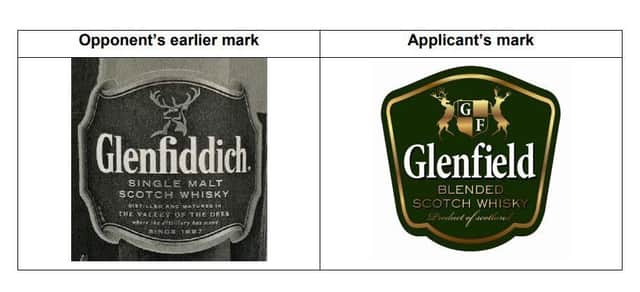Glenfiddich makers lose copyright row over Indian rival’s whisky


Indian businessman Vivek Anasane, 41, wants to expand his Mumbai-based drinks firm into the UK with the launch of a Scotch called Glenfield. He applied to register the name of the blended whisky as a trademark to protect its brand.
However, William Grant & Sons, who own Glenfiddich – the world’s biggest selling single malt whisky – objected to the move. The company’s lawyers said the application overlapped with their registered trademark and people could confuse the two products.
Advertisement
Hide AdAdvertisement
Hide AdAs well as having a similar name, Glenfield uses the same green and gold colours on its label and also features a stag.
Glenfiddich bosses claimed Glenfield could benefit from this confusion and called for their application to be blocked. Now the UK Intellectual Property Office (IPO) has found in Glenfield’s favour and said consumers were unlikely to confuse the two whiskies.
In a written ruling, trademark hearing officer Mark Bryant said: “Conceptually, other than the common occurrence of GLEN, meaning ‘a narrow valley, especially in Scotland or Ireland’, the respective marks have no conceptual similarity.
“The common occurrence of the GLEN element is likely to be readily understood by the average consumer as an allusion to Scotland.
“This is likely to be the overriding perception of the consumer and I am of the view that the applicant’s mark will not even bring the opponent’s mark to mind let alone confuse the consumer into believing that the goods sold under the respective marks originate from the same or linked undertaking.
“Next I turn to consider the question of misrepresentation of the opponent’s label mark.
“The presence of a device of a single stag exhibits differences to the applicant’s heraldic device featuring two stags rampant that are unlikely to go unnoticed.
“In respect of the colour combinations, these provide some similarity and may serve to fleetingly bring the other mark to mind, but the significant differences, particularly in the dominant elements Glenfiddich and Glenfield are such that I find the differences outweigh the similarities and the applicant’s mark will do no more than bring the opponent’s mark fleetingly to mind.” Coralie Vial, global brand manager for William Grant & Sons, said in evidence the Glenfiddich trademark brand had been in existence since 1960 and had been using green and gold colours for many years.
William Grant & Sons have been approached for comment.
